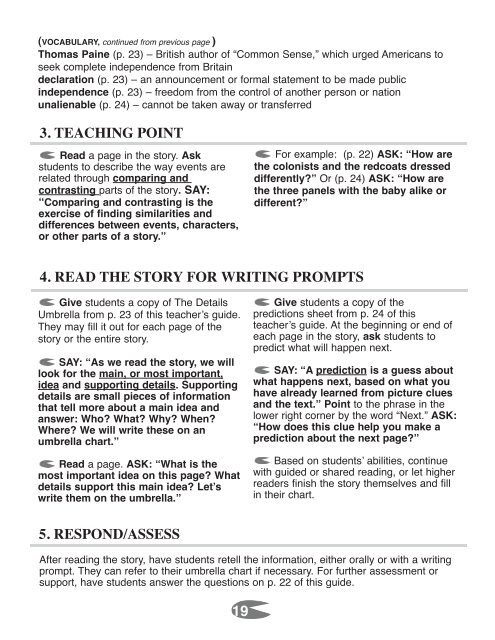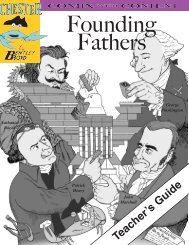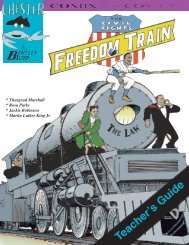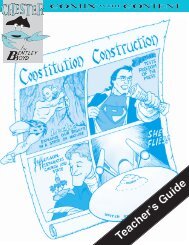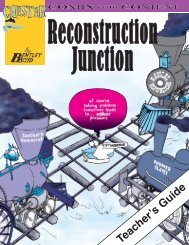Teacher's Guide - Chester Comix
Teacher's Guide - Chester Comix
Teacher's Guide - Chester Comix
Create successful ePaper yourself
Turn your PDF publications into a flip-book with our unique Google optimized e-Paper software.
(VOCABULARY, continued from previous page )<br />
Thomas Paine (p. 23) – British author of “Common Sense,” which urged Americans to<br />
seek complete independence from Britain<br />
declaration (p. 23) – an announcement or formal statement to be made public<br />
independence (p. 23) – freedom from the control of another person or nation<br />
unalienable (p. 24) – cannot be taken away or transferred<br />
3. TEACHING POINT<br />
Read a page in the story. Ask<br />
students to describe the way events are<br />
related through comparing and<br />
contrasting parts of the story. SAY:<br />
“Comparing and contrasting is the<br />
exercise of finding similarities and<br />
differences between events, characters,<br />
or other parts of a story.”<br />
For example: (p. 22) ASK: “How are<br />
the colonists and the redcoats dressed<br />
differently” Or (p. 24) ASK: “How are<br />
the three panels with the baby alike or<br />
different”<br />
4. READ THE STORY FOR WRITING PROMPTS<br />
Give students a copy of The Details<br />
Umbrella from p. 23 of this teacher’s guide.<br />
They may fill it out for each page of the<br />
story or the entire story.<br />
SAY: “As we read the story, we will<br />
look for the main, or most important,<br />
idea and supporting details. Supporting<br />
details are small pieces of information<br />
that tell more about a main idea and<br />
answer: Who What Why When<br />
Where We will write these on an<br />
umbrella chart.”<br />
Read a page. ASK: “What is the<br />
most important idea on this page What<br />
details support this main idea Let’s<br />
write them on the umbrella.”<br />
Give students a copy of the<br />
predictions sheet from p. 24 of this<br />
teacher’s guide. At the beginning or end of<br />
each page in the story, ask students to<br />
predict what will happen next.<br />
SAY: “A prediction is a guess about<br />
what happens next, based on what you<br />
have already learned from picture clues<br />
and the text.” Point to the phrase in the<br />
lower right corner by the word “Next.” ASK:<br />
“How does this clue help you make a<br />
prediction about the next page”<br />
Based on students’ abilities, continue<br />
with guided or shared reading, or let higher<br />
readers finish the story themselves and fill<br />
in their chart.<br />
5. RESPOND/ASSESS<br />
After reading the story, have students retell the information, either orally or with a writing<br />
prompt. They can refer to their umbrella chart if necessary. For further assessment or<br />
support, have students answer the questions on p. 22 of this guide.<br />
19


